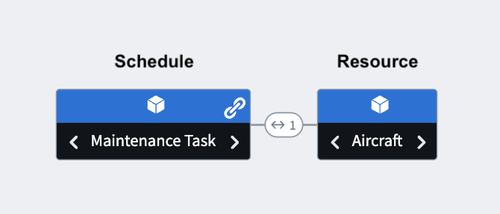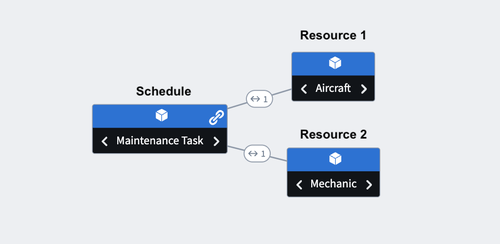Ontology primitives and data model configuration
The Ontology primitives for dynamic scheduling are comprised of one Schedule object and one or more Resource objects. Begin by creating your objects in the Ontology Manager. At a minimum, the Workshop widget requires two object types: a Schedule object and a Resource object.
| Object Type | Description |
|---|---|
| Schedule object | A schedule object represents the task or activity of interest and should include a start and end time of when that event is occurring and/or the expected duration. |
| Resource object | A resource object represents any entity (such as a person, location, project, etc.) that the schedule object is being assigned to or scheduled against. |
Ontology requirements
The Schedule object must meet the property and link requirements outlined below.
Required schedule object properties
| Object property | Type |
|---|---|
| Foreign key to resource | String |
| Start time | Timestamp |
| End time | Timestamp |
Required Ontology links
The schedule object type should be linked to each resource object type in a many-to-one relationship. For instance, in the example above, many tasks can be assigned to one aircraft.
The scheduling Gantt chart does not support many-to-many relationship links between object types.
Example: Aircraft maintenance schedule
The example below demonstrates the process of scheduling maintenance tasks for aircraft.
Simple configuration
The two-object-type configuration, the minimum requirement for the Dynamic Scheduling Workshop widget, is illustrated below.
- Schedule object type: In the example below, maintenance tasks are a time-bound activity.
- Resource object type: Aircraft are the object/place where the tasks are conducted.

Advanced configuration
The dynamic scheduling data supports a variety of additional configurations beyond the two-object-type model, allowing application builders to create complex, advanced workflows.
Building on the two-object-type model above, in addition to scheduling when maintenance tasks will occur on an assigned aircraft, users can also determine who will carry out the maintenance task by assigning the task to a specific mechanic. In this new Ontology, as pictured below, the mechanic object acts as a second resource object type, which can be unlimited in number.
- Schedule object type: Maintenance tasks are a time-bound activity.
- Resource object type 1: Aircraft are the object/place where the tasks are conducted.
- Resource object type 2: Mechanic who will carry out the assigned maintenance task.
